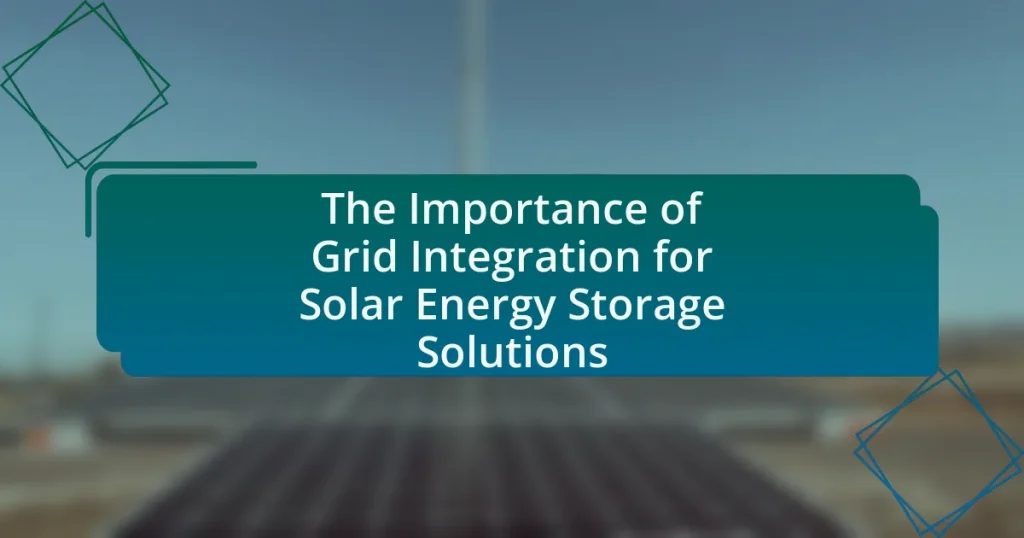Grid integration is a critical component for enhancing the reliability and efficiency of solar energy storage solutions. This article explores how connecting solar systems to the grid allows for the storage and distribution of excess energy, thereby stabilizing energy supply and reducing reliance on fossil fuels. Key components of grid integration, such as energy management systems, inverters, and battery storage, are discussed, along with the impact of regulatory frameworks and technological advancements on successful integration. Additionally, the article addresses the challenges faced in grid integration and outlines best practices for optimizing the performance of solar energy storage within the grid.
What is the Importance of Grid Integration for Solar Energy Storage Solutions?
Grid integration is crucial for solar energy storage solutions as it enhances the reliability and efficiency of energy distribution. By connecting solar energy systems to the grid, excess energy generated during peak sunlight hours can be stored and dispatched when demand is high or sunlight is low. This integration facilitates a more stable energy supply, reduces reliance on fossil fuels, and supports the transition to renewable energy sources. According to the U.S. Department of Energy, grid-connected solar storage systems can provide ancillary services, such as frequency regulation and voltage support, which are essential for maintaining grid stability.
How does grid integration enhance solar energy storage systems?
Grid integration enhances solar energy storage systems by enabling efficient energy management and optimizing the use of stored solar energy. This integration allows for real-time balancing of supply and demand, facilitating the transfer of excess solar energy to the grid during peak production times and drawing from the grid during low production periods. According to the National Renewable Energy Laboratory, grid-connected solar energy systems can reduce reliance on fossil fuels and improve overall energy efficiency by up to 30%. This capability not only maximizes the utilization of renewable energy but also stabilizes the grid, making it more resilient to fluctuations in energy supply.
What are the key components of grid integration in solar energy storage?
The key components of grid integration in solar energy storage include energy management systems, inverters, battery storage systems, and grid communication technologies. Energy management systems optimize the use of stored energy and manage demand response, ensuring efficient energy distribution. Inverters convert the direct current (DC) from solar panels and batteries into alternating current (AC) for grid compatibility, which is essential for integrating renewable energy sources. Battery storage systems provide the necessary capacity to store excess solar energy for later use, enhancing grid reliability and stability. Grid communication technologies facilitate real-time data exchange between solar energy systems and the grid, enabling better coordination and management of energy resources. These components collectively enhance the efficiency and reliability of solar energy integration into the existing power grid.
How does grid integration impact energy efficiency in solar systems?
Grid integration significantly enhances energy efficiency in solar systems by enabling optimized energy distribution and consumption. When solar energy systems are connected to the grid, they can supply excess energy during peak production times, reducing waste and improving overall system efficiency. According to the National Renewable Energy Laboratory, grid-connected solar systems can achieve up to 20% higher efficiency compared to isolated systems, as they can draw from the grid during low production periods and supply energy back during high production, thus balancing supply and demand effectively. This integration also facilitates the use of advanced energy management technologies, which further optimize energy usage and reduce losses.
Why is grid integration crucial for renewable energy adoption?
Grid integration is crucial for renewable energy adoption because it enables the efficient distribution and utilization of renewable resources like solar and wind energy. By connecting renewable energy sources to the grid, energy can be transmitted to where it is needed most, balancing supply and demand effectively. This integration facilitates the use of energy storage systems, which can store excess energy generated during peak production times and release it during periods of high demand or low generation. According to the International Renewable Energy Agency, grid integration can increase the share of renewables in the energy mix, leading to a more resilient and sustainable energy system.
What role does grid integration play in stabilizing energy supply?
Grid integration plays a crucial role in stabilizing energy supply by enabling the efficient management and distribution of electricity from diverse sources, including renewable energy. This integration allows for real-time balancing of supply and demand, which is essential for maintaining grid reliability, especially as the share of variable renewable energy sources like solar and wind increases. For instance, according to the U.S. Department of Energy, effective grid integration can reduce the need for fossil fuel backup generation by up to 30%, thereby enhancing energy security and reducing greenhouse gas emissions.
How does grid integration facilitate the transition to a sustainable energy future?
Grid integration facilitates the transition to a sustainable energy future by enabling the efficient management and distribution of renewable energy sources, such as solar and wind. This integration allows for the balancing of supply and demand, ensuring that excess energy generated during peak production times can be stored and utilized when demand is high. For instance, according to the International Renewable Energy Agency, grid integration can increase the share of renewables in the energy mix, reducing reliance on fossil fuels and lowering greenhouse gas emissions. Furthermore, advanced grid technologies, such as smart grids, enhance the resilience and flexibility of energy systems, making it easier to incorporate diverse energy sources and improve overall energy efficiency.
What challenges are associated with grid integration for solar energy storage?
The challenges associated with grid integration for solar energy storage include technical, regulatory, and economic barriers. Technical challenges involve the need for advanced grid infrastructure to manage variable solar output and ensure reliability. Regulatory challenges stem from outdated policies that may not accommodate new technologies or incentivize energy storage solutions. Economic barriers include high initial costs for storage systems and the need for financial models that support long-term investments. These challenges hinder the effective deployment of solar energy storage, impacting overall energy transition efforts.
What technical barriers exist in grid integration?
Technical barriers in grid integration include insufficient infrastructure, interoperability issues, and regulatory challenges. Insufficient infrastructure refers to the lack of adequate transmission lines and substations to handle increased renewable energy inputs, which can lead to congestion and reliability issues. Interoperability issues arise from the diverse technologies and systems used in energy generation and storage, making it difficult for them to communicate effectively. Regulatory challenges involve outdated policies that do not accommodate the rapid growth of renewable energy sources, hindering their integration into existing grids. These barriers collectively impede the efficient incorporation of solar energy storage solutions into the grid.
How do regulatory frameworks affect grid integration efforts?
Regulatory frameworks significantly influence grid integration efforts by establishing the rules and standards that govern energy markets and infrastructure. These frameworks dictate how renewable energy sources, such as solar, can be connected to the grid, impacting the speed and efficiency of integration. For instance, policies that promote net metering and feed-in tariffs incentivize the adoption of solar energy, facilitating its integration into existing grid systems. Additionally, regulations that require utilities to invest in grid modernization enhance the capacity to accommodate distributed energy resources, thereby improving overall grid reliability and resilience.
What are the financial implications of grid integration for solar projects?
Grid integration for solar projects significantly impacts financial viability by enhancing revenue streams and reducing operational costs. By connecting solar systems to the grid, projects can sell excess energy during peak demand periods, leading to increased income. Additionally, grid integration allows for participation in demand response programs, which can provide financial incentives for reducing energy consumption during peak times.
Moreover, studies indicate that grid-connected solar projects can benefit from lower financing costs due to perceived lower risk by investors. For instance, a report by the International Renewable Energy Agency (IRENA) highlights that integrated solar systems can achieve a levelized cost of electricity (LCOE) that is 30-50% lower than standalone systems due to economies of scale and improved efficiency.
Furthermore, grid integration can mitigate the financial risks associated with energy price volatility, as it provides a stable revenue source through power purchase agreements (PPAs) with utilities. Overall, the financial implications of grid integration for solar projects are overwhelmingly positive, leading to increased profitability and sustainability in the renewable energy sector.
How can these challenges be overcome?
To overcome the challenges of grid integration for solar energy storage solutions, implementing advanced energy management systems is essential. These systems optimize the use of solar energy by balancing supply and demand, thereby enhancing grid stability. For instance, the integration of smart grid technologies allows for real-time monitoring and control of energy flows, which can significantly reduce the risk of overloads and outages. Additionally, regulatory frameworks that incentivize investment in renewable energy infrastructure can facilitate smoother integration. According to the International Renewable Energy Agency, countries that have adopted supportive policies have seen a 30% increase in renewable energy capacity, demonstrating the effectiveness of such measures in overcoming integration challenges.
What innovative technologies are being developed to support grid integration?
Innovative technologies being developed to support grid integration include advanced energy management systems, smart inverters, and vehicle-to-grid (V2G) technology. Advanced energy management systems optimize the use of distributed energy resources, enhancing grid reliability and efficiency. Smart inverters facilitate the integration of renewable energy sources by converting direct current to alternating current while providing grid support functions such as voltage regulation. Vehicle-to-grid technology allows electric vehicles to discharge energy back to the grid, thus balancing supply and demand. These technologies are crucial for accommodating the increasing penetration of renewable energy sources and improving overall grid resilience.
How can policy changes promote better grid integration for solar energy?
Policy changes can promote better grid integration for solar energy by establishing supportive regulatory frameworks and incentivizing infrastructure investments. For instance, implementing feed-in tariffs or power purchase agreements can encourage the development of solar projects, ensuring that solar energy is prioritized in the energy mix. Additionally, policies that facilitate the interconnection of solar systems to the grid can reduce barriers for solar energy producers, enhancing overall grid reliability. Evidence from countries like Germany, which has successfully integrated high levels of solar energy through supportive policies, demonstrates that strategic regulatory changes can lead to significant improvements in grid integration and energy stability.
What are the future trends in grid integration for solar energy storage solutions?
Future trends in grid integration for solar energy storage solutions include increased adoption of advanced energy management systems, enhanced grid flexibility through smart grid technologies, and the integration of artificial intelligence for predictive analytics. These trends are driven by the need for improved efficiency and reliability in energy distribution, as evidenced by the growing deployment of battery storage systems, which are projected to reach a cumulative capacity of over 1,000 GWh by 2030 according to the International Energy Agency. Additionally, regulatory frameworks are evolving to support decentralized energy systems, facilitating greater participation of renewable energy sources in the grid.
How is the role of smart grids evolving in solar energy storage?
Smart grids are increasingly becoming integral to solar energy storage by enhancing the efficiency and reliability of energy distribution. They facilitate real-time monitoring and management of energy flow, allowing for better integration of solar power into the grid. This evolution is supported by advancements in technology, such as smart meters and automated demand response systems, which optimize energy usage and storage based on supply and demand dynamics. According to the U.S. Department of Energy, smart grid technologies can reduce energy losses by up to 30%, significantly improving the viability of solar energy storage solutions.
What advancements in battery technology are influencing grid integration?
Advancements in battery technology influencing grid integration include the development of solid-state batteries, improved lithium-ion batteries, and flow batteries. Solid-state batteries offer higher energy density and enhanced safety, which can facilitate the integration of renewable energy sources into the grid by providing more efficient energy storage. Improved lithium-ion batteries have seen advancements in cycle life and charging speed, making them more viable for grid applications. Flow batteries, with their ability to decouple energy and power, provide long-duration storage solutions that are essential for balancing supply and demand in grid systems. These technologies collectively enhance the reliability and efficiency of energy storage, supporting the transition to a more sustainable energy grid.
How are consumer behaviors impacting grid integration strategies?
Consumer behaviors are significantly influencing grid integration strategies by driving demand for renewable energy sources and energy storage solutions. As more consumers adopt solar energy systems and energy-efficient technologies, utilities are compelled to adapt their grid integration strategies to accommodate increased distributed energy resources. For instance, a report from the U.S. Energy Information Administration indicates that residential solar installations have surged, leading to a need for enhanced grid flexibility and management systems to handle variable energy inputs. This shift in consumer preferences towards sustainable energy sources necessitates the development of advanced grid technologies, such as smart grids and demand response programs, to optimize energy distribution and maintain grid reliability.
What best practices should be followed for effective grid integration?
Effective grid integration requires the implementation of advanced forecasting techniques, robust communication systems, and flexible grid management strategies. Advanced forecasting techniques, such as predictive analytics, enhance the accuracy of energy generation predictions, allowing for better alignment with demand. Robust communication systems facilitate real-time data exchange between energy producers and grid operators, ensuring timely responses to fluctuations in supply and demand. Flexible grid management strategies, including demand response programs and energy storage solutions, enable the grid to adapt to variable renewable energy sources, thereby improving reliability and efficiency. These practices are essential for optimizing the performance of solar energy storage solutions within the grid.
How can stakeholders collaborate to enhance grid integration?
Stakeholders can collaborate to enhance grid integration by establishing partnerships that facilitate information sharing, joint investments in infrastructure, and coordinated policy advocacy. For instance, utilities, renewable energy developers, and regulatory bodies can work together to create standardized protocols for integrating solar energy storage systems into the grid. This collaboration can lead to improved grid reliability and efficiency, as evidenced by studies showing that regions with strong stakeholder cooperation experience fewer outages and better energy management. Additionally, initiatives like the U.S. Department of Energy’s Solar Energy Technologies Office promote collaboration among stakeholders to advance grid integration technologies, demonstrating the effectiveness of collective efforts in achieving common goals.
What are the key considerations for successful implementation of grid integration?
Successful implementation of grid integration requires careful consideration of regulatory frameworks, technological compatibility, and stakeholder engagement. Regulatory frameworks must support the integration of renewable energy sources, ensuring that policies incentivize grid enhancements and facilitate interconnection. Technological compatibility involves ensuring that solar energy storage systems can effectively communicate and operate within existing grid infrastructure, which may require upgrades or new technologies. Stakeholder engagement is crucial, as collaboration among utilities, government agencies, and the community fosters acceptance and addresses concerns related to grid changes. These considerations are essential for achieving a reliable and efficient grid that can accommodate increased solar energy storage solutions.


